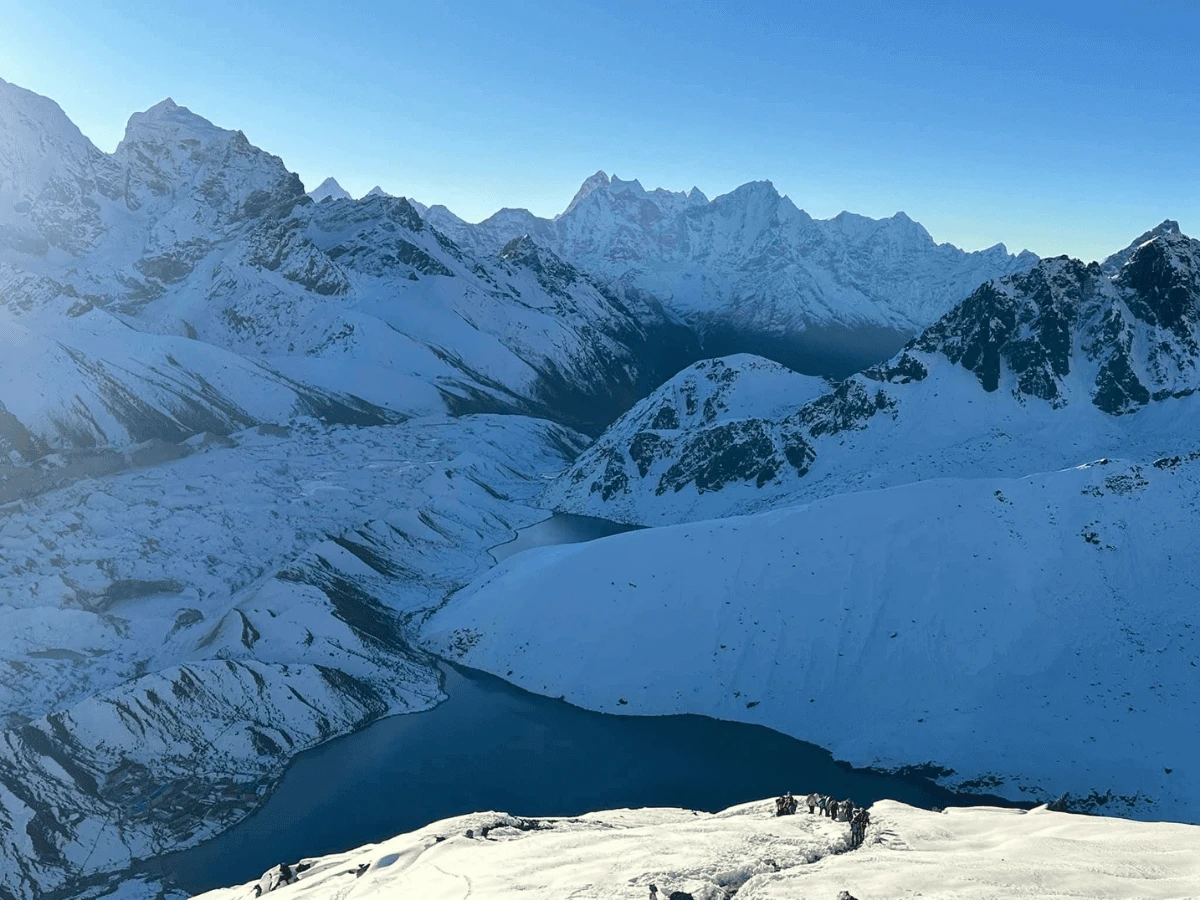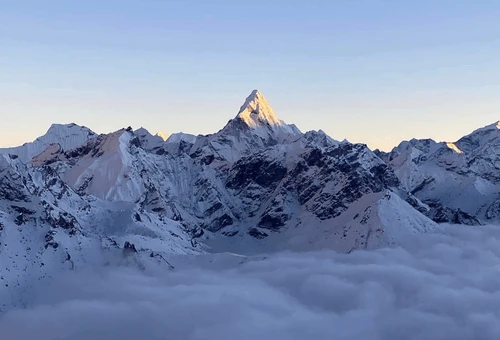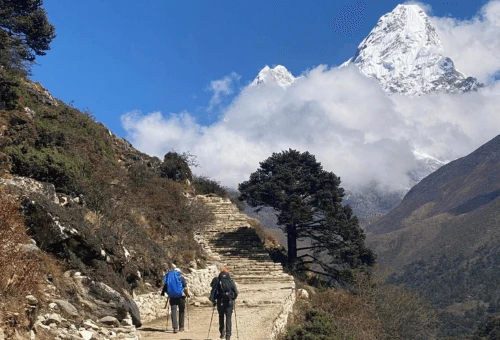The Gokyo Valley Trek is a remarkable trip in the Everest Region that leads you to the stunning Gokyo Lakes, the world’s highest freshwater lake system. This off-the-beaten-path journey offers a more serene alternative to the classic Everest Base Camp 14 Days. Trekkers travel through Sagarmatha National Park, lush rhododendron forests, roaring rivers, and culturally rich Sherpa villages.
The trail reaches Gokyo Ri (5,357 m), a vantage point providing breathtaking panoramic views of Mount Everest, Lhotse, Cho Oyu,Makalu, and other Himalayan giants. Along the way, you’ll experience the warm hospitality of the Sherpa people and stay in cosy teahouses in small settlements like Namche Bazaar, Dole, and Machhermo.
If you want to avoid the crowd of the classic EBC Trek route, then the Gokyo Trek is the best alternative trek. The journey typically begins with a thrilling flight to Lukla, then winds up the Dudh Koshi River valley to the bustling Namche Bazaar. From Namche, the trail continues through the villages like Dole and Machermo to reach the Gokyo Valley.
It’s a moderately strenuous trek suitable for trekkers with good fitness and some high-altitude trekking experience. Proper acclimatisation and preparation are crucial, as you’ll be hiking to elevations above 5,300 m in approximately two weeks. In summary, the Gokyo Valley Trek promises adventure, natural beauty, and cultural insights on a route less travelled, truly living up to its reputation as one of the finest Everest region treks.
Do you know, you can do the Everest Gokyo Valley Trek in 15 Days, combining the trek with Everest Base Camp.
How Long is the Gokyo Valley Trek in the Everest?
The length of the Gokyo Valley Trek can vary depending on the exact route and acclimatisation needs, but it typically takes around 10–12 days of actual trekking from Lukla back to Lukla. Our itinerary below outlines a 10-day Gokyo Valley trek. Standard Gokyo trek packages often span 11–14 days to allow for additional acclimatisation; often trekkers spend one extra day in Gokyo Valley. In terms of distance, you will be walking roughly 100 km in total throughout the trek. The route entails steady ascents up the Dudh Koshi valley, with a major elevation gain from Lukla (2,840 m) to Gokyo Ri (5,357 m).
Magnificent Views of Mount Everest from the Gokyo Ri Hike
The main highlight of this 10-Day Gokyo Valley Trek is a Hike to Gokyo Ri to witness the views of 8000-meter mountains, including Mount Everest. Gokyo Ri is a rocky peak just above Gokyo village that delivers magnificent views of Mount Everest and other neighbouring peaks.
Starting early before dawn, reaching the summit in time for sunrise provides a truly magical scene: the first rays of the sun paint the tips of Everest, Lhotse, Makalu, and Cho Oyu in gold. Trekkers often describe the 360-degree panorama from Gokyo Ri as one of the best in the Himalayas. It offers one of the most breathtaking panoramic views of the entire Everest range.
Moreover, from the top of the Gokyo Ri, see the chain of turquoise Gokyo Lakes glittering in the valley below and the immense Ngozumpa Glacier – Nepal’s longest glacier. Mount Everest itself stands about 20 km away to the east. To the north, Cho Oyu (8,188 m) looms just above Gokyo, remarkably close. To the east are Everest (8,849 m) and Lhotse (8,516 m), and further afar to the southeast, Makalu (8,485 m) peeks out.
The hike to Gokyo Ri is challenging, typically a 2–3 hour steep climb on a switchback trail that gains over 500 m in elevation. But your reward is the jaw-dropping view and an incredible sense of accomplishment. Many trekkers spend an hour or more on the summit of Gokyo Ri, taking photos and simply soaking in the Himalayan grandeur. Standing there, gazing at Mount Everest and the surrounding summits in the crisp morning light, is a moment you’ll treasure long after the trek. It’s the crowning achievement of the Gokyo Valley Trek.
Combine the Gokyo Valley Trek with the Everest Base Camp Camp
For those who want to experience Everest Base Camp as well as Gokyo, there is an exciting alternative: combining the Gokyo Valley route with the EBC trail. This typically involves doing a circuit via the Cho La Pass (5,420 m), which connects Gokyo with the EBC Trek route. This combined itinerary is often called the Gokyo Cho La Pass Trek or the Everest Gokyo Valley Trek.
Keep in mind that adding EBC via Cho La Pass is strenuous and takes extra days. It’s recommended only if you have a bit more time and are confident in your fitness and ability to handle high altitude. The scenery on the pass crossing is dramatic – you traverse a glacier and are surrounded by mountain vistas.
10-Day Gokyo Valley Trek cost 2026,2027
The cost of the Gokyo Valley (Gokyo Ri) Trek can vary widely depending on the level of service, group size, and whether you trek independently or with an organised package. Generally speaking, a guided Gokyo Valley Trek package of about 10–14 days will range from approximately USD 1,200 up to $2,500 per person. This typically includes the major expenses like internal flights (Kathmandu–Lukla round trip), trekking permits, guide, accommodations in teahouses, and meals during the trek. The lower end of the range might be a basic package with tea-house accommodation and minimal extras, while the higher end could involve more comfortable lodge options or all-inclusive services.
Join Mountain Eco Trails for the 10-Day Gokyo Valley Trek
Trek with Mountain Eco Trails for a professionally organised and eco-conscious adventure in the Himalayas. Mountain Eco Trails is a leading local trekking company in Nepal known for its commitment to sustainable travel and excellent client service. Choosing to do your Gokyo Valley Trek with Mountain Eco Trails means you’ll benefit from experienced Sherpa guides, well-planned itineraries, and personalised attention every step of the way. Here are the benefits of choosing Mountain Eco Trails for the Gokyo Lake Trek in Nepal:
- Complimentary Airport pick-up and drop-off. (if needed)
- An experienced trekking guide who knows the trail like a home.
- Hassle-free last-minute booking and trek arrangements.
- Trekking Poles, Duffel Bag, and SIM card if needed.
- First Aid Kid carried by the trekking Guide.
- Regular communication with the trekking leader during the trek.
- A complimentary farewell dinner before departing from Nepal.
- Complimentary Trekker's Massage after the trek
If you are still confused about any of the services, feel free to contact us via email or WhatsApp at +9779849790153.






